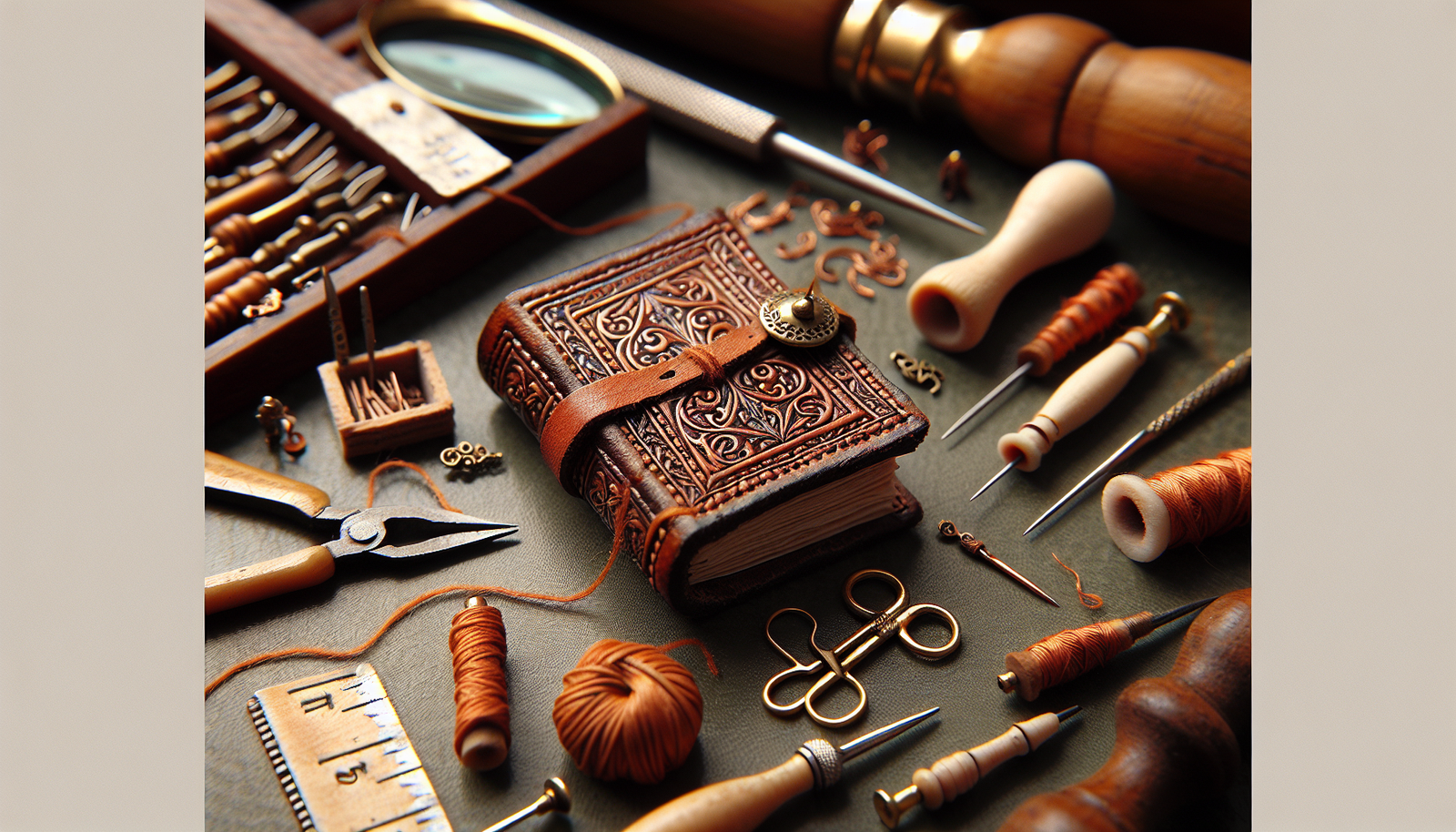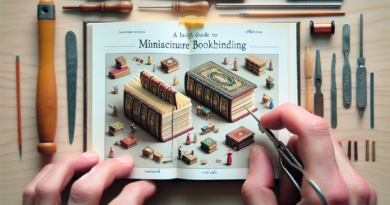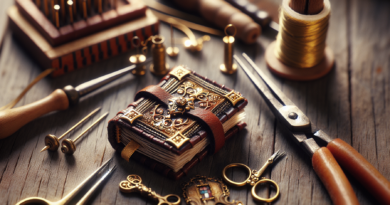Exploring the Art of Miniature Bookbinding
So, you’re ready to dive into the fascinating world of miniature bookbinding, huh? Well, get ready to be amazed because this is an art form like no other. In this article, we will explore the intricacies of creating these tiny masterpieces that are both visually stunning and incredibly detailed. From the meticulous craftsmanship to the delicate materials used, miniature bookbinding is a labor of love that requires skill, patience, and a whole lot of creativity. So, buckle up and prepare to be enchanted by the world of miniature bookbinding.
History of Miniature Bookbinding
The art of miniature bookbinding has a rich and fascinating history that dates back centuries. From its origins to its development and popularity, miniature bookbinding has captivated book lovers and bookbinders alike.
Origins of Miniature Bookbinding
The origins of miniature bookbinding can be traced back to ancient civilizations such as the Egyptians, Greeks, and Romans. These early civilizations began creating miniature books as a way to preserve and transmit important information. Miniature bookbinding techniques started as an efficient means of producing portable books that could be easily carried and shared.
As time went on, miniature bookbinding evolved and became more intricate. In medieval times, religious texts were often created in miniature form, adorned with ornate decorations, and used as devotional items. The use of miniature books continued to grow throughout the Renaissance and Enlightenment periods, with miniature bookbindings crafted for the wealthy elite as symbols of status and wealth.
Development and Popularity of Miniature Books
The popularity of miniature books surged during the 19th century, as advancements in printing and bookbinding technology allowed for more precise and detailed craftsmanship. As literacy rates increased and the availability of books expanded, miniature bookbinding became a treasured art form among book collectors and enthusiasts.
During this time, miniature books were often produced as novelty items or souvenirs. They were created for special occasions such as weddings or anniversaries, with personalized inscriptions and illustrations. Famous authors and prominent figures also contributed to the popularity of miniature books by writing or illustrating their own works on a smaller scale.
The demand for miniature books continued into the 20th century, with bookbinders experimenting with new styles, techniques, and materials. The rise of the Arts and Crafts movement in the early 1900s further propelled the art of miniature bookbinding, as artisans sought to create beautiful and functional books using traditional methods.
Materials Used in Miniature Bookbinding
Miniature bookbinders have used a variety of materials throughout history, both traditional and modern, to create their intricate masterpieces.
Traditional Materials
Traditionally, miniature bookbinding relied on materials such as vellum, parchment, and fine leather for the covers. These materials provided durability and an elegant aesthetic. The use of gold, silver, and other precious metals for embellishments and tooling was also common, adding a touch of luxury to the miniature books.
For the pages, high-quality paper made from cotton or linen fibers was employed. This paper ensured the durability and longevity of the miniature books, allowing them to withstand repeated use and handling.
Modern Materials
In modern miniature bookbinding, traditional materials are still employed, but bookbinders have also embraced new materials to add variety and innovation to their craft. Synthetic materials like vinyl, faux leather, and book cloth are commonly used for covers, offering a range of colors and textures to suit different design preferences.
The use of archival-quality paper has also become more prevalent in modern miniature bookbinding to ensure the preservation of the books over time. Additionally, bookbinders may incorporate materials such as ribbons, beads, and decorative papers to enhance the visual appeal of their miniature creations.

Tools and Techniques in Miniature Bookbinding
To bring their miniature bookbinding projects to life, bookbinders rely on a variety of essential tools and employ specific techniques tailored to the unique challenges of working on a small scale.
Essential Tools for Miniature Bookbinding
Some essential tools for miniature bookbinding include:
- Scalpel or X-acto knife: These precision cutting tools allow bookbinders to make precise and clean cuts on materials such as paper, fabric, and leather.
- Bone folder: Used for folding and creasing paper, the bone folder helps bookbinders create sharp and well-defined folds.
- Awl: This tool is used to create small holes in the pages and covers of the book, allowing for the stitching or sewing of the binding.
- Bookbinding needle: A smaller needle is essential for miniature bookbinding, enabling bookbinders to navigate tight spaces and securely bind the pages together.
- PVA glue: A high-quality adhesive that provides a strong bond without warping the pages or compromising the integrity of the book.
Techniques for Binding Miniature Books
Binding miniature books requires specialized techniques to ensure the books are sturdy, well-constructed, and visually appealing. Some commonly used techniques for miniature bookbinding include:
- Coptic Stitch: The Coptic stitch binding technique involves sewing the pages directly onto the covers, creating a visible thread pattern along the spine. This method allows the book to lay flat when open, making it ideal for miniature books that need to be easily read or displayed.
- Accordion Fold: The accordion fold binding technique utilizes a continuous fold to create pages that unfold like an accordion. This method is used for miniature books that require a compact and portable design.
- Sewn Binding: Similar to traditional bookbinding, sewn binding involves stitching the pages together using a needle and thread. This technique provides durability and flexibility for the miniature books.
- Pamphlet Stitch: The pamphlet stitch involves sewing a few folded sheets of paper or folios along the spine. This technique is often used for pamphlets or smaller-scale miniature books.
Design and Layout in Miniature Bookbinding
Design and layout play crucial roles in miniature bookbinding, as the smaller scale requires careful consideration to ensure the overall aesthetic and functionality of the book.
Considerations for Designing Miniature Books
When designing a miniature book, factors such as the dimensions, proportions, and overall theme must be taken into account. The size of the book impacts the readability of the text and the visibility of any illustrations or decorations. Therefore, bookbinders need to strike a balance between creating a miniature book that is visually captivating and functional for the reader.
The proportions of the book also need to be carefully considered. The size of the text, spacing between lines, and margins all contribute to the readability and overall visual appeal of the miniature book.
Additionally, bookbinders may choose to incorporate decorative elements such as blind tooling, gold leaf, or embossing to enhance the design of the book and add a touch of elegance.
Creating Layouts for Miniature Books
Creating layouts for miniature books requires meticulous planning and precision. Bookbinders may sketch out the layout on paper or use design software to visualize the final product before starting the binding process. They consider factors such as the placement of text, illustrations, chapter headings, and page numbers to ensure a cohesive and visually pleasing layout.
Bookbinders must also take the physical properties of the materials into account. The weight, thickness, and flexibility of the paper and covers must be considered to create a layout that allows the book to open and close smoothly without damaging the pages or compromising the binding.

Types of Miniature Bookbindings
Miniature bookbinding encompasses a variety of binding styles, each offering its own unique aesthetic and functional characteristics.
Accordion Fold Binding
The accordion fold binding technique, as mentioned earlier, is used for miniature books that require a compact and portable design. The pages of the book are folded in an accordion-like manner, allowing the book to be easily expanded or contracted. This binding style is well-suited for showcasing illustrations or photographs as they can be unfolded and displayed in a continuous format.
Sewn Binding
Sewn binding is a common method used in both traditional and miniature bookbinding. It involves sewing the folios or sections of the book together using a needle and thread. The sewing creates a sturdy and durable binding that allows the book to lie flat when opened. This type of binding is often used for miniature books with a larger number of pages or for books that need to withstand frequent handling.
Pamphlet Stitch Binding
The pamphlet stitch binding technique involves sewing a few folded sheets of paper or folios along the spine. This simple and practical binding style is often used for pamphlets or small-scale miniatures that have fewer pages. It provides a secure and flexible binding that allows for easy browsing or reading.
Coptic Stitch Binding
The Coptic stitch binding technique is a historic method that originated in ancient Egypt. It involves sewing the pages directly onto the covers, creating a visible thread pattern along the spine of the book. The advantage of this binding style for miniature books is that it allows the book to lay flat when open. This makes it ideal for miniature books that need to be easily read or displayed, as the pages do not spring closed.
The Role of Miniature Bookbinding in Book Arts
Miniature bookbinding holds a significant place in the broader world of book arts, serving as both an art form and a medium for creative expression.
Miniature Bookbinding as an Art Form
Miniature bookbinding is considered a highly specialized art form that requires exceptional skill and craftsmanship. Bookbinders approach their creations as small-scale works of art, paying meticulous attention to every detail, from the choice of materials to the intricacies of the binding techniques used.
The artistry of miniature bookbinding extends beyond the physical aspects of the book. Bookbinders often incorporate creative illustrations, calligraphy, or hand-painted designs to enhance the aesthetic appeal and storytelling elements of their miniature books. Each miniature volume becomes a unique expression of the bookbinder’s creativity and artistry.
Collecting and Exhibiting Miniature Books
Miniature books have long been treasured by collectors and enthusiasts who appreciate their beauty, craftsmanship, and historical significance. Collectors often seek out miniature books that showcase exceptional binding techniques, unique materials, or rare subject matter.
Exhibitions dedicated to miniature books provide a platform for bookbinders to showcase their creations and for collectors to share their rare treasures with a wider audience. These exhibitions often feature themed displays, allowing visitors to appreciate the diversity and artistry of miniature bookbinding.
Challenges in Miniature Bookbinding
Working on a miniature scale presents bookbinders with unique challenges that require precision and attention to detail.
Working with Limited Space
The small size of miniature books presents challenges in handling and manipulating the materials. Bookbinders must have steady hands and excellent fine motor skills to navigate the tight spaces and create neat and precise folds, stitches, and attachments.
Choosing appropriate tools that allow for precise cutting, folding, and sewing is essential to overcoming the challenges of limited space. Bookbinders often need to adapt and modify traditional bookbinding tools to suit the needs of miniature bookbinding.
Precision and Attention to Detail
Miniature bookbinding requires a high level of precision and attention to detail due to the small size of the materials. Every stitch, fold, and cut must be executed flawlessly to ensure the structural integrity and aesthetic appeal of the finished book. Bookbinders must pay careful attention to measurements, alignment, and symmetry to create miniature books that are visually pleasing and functional.
Attention to detail extends to the selection of materials and the incorporation of decorative elements. Bookbinders must consider the weight, texture, and color of the materials to ensure they harmonize with the overall design of the book. Additionally, applying decorations such as gold leaf or tooling requires a steady hand and meticulous placement to achieve the desired effect.
Exploring Miniature Bookbinding Styles
Over the centuries, miniature bookbinding has encompassed a wide range of styles, reflecting the tastes, trends, and artistic movements of different eras.
Historical Miniature Bookbinding Styles
Throughout history, various miniature bookbinding styles have emerged, each influenced by the prevailing artistic and cultural trends of its time. Some notable historical styles include:
- Gothic Bindings: Popular during the Middle Ages, Gothic bindings featured intricate tooling, embossing, and precious metal accents, often depicting religious motifs.
- Renaissance Bindings: Renaissance bindings were characterized by elaborate gold tooling, gilding, and intricate decorations such as filigree and medallions. These bindings often incorporated classical mythological themes.
- Victorian Bindings: Victorian-era miniature bookbindings showcased the extravagant and ornamental style of the period. They were often embellished with colorful leather, inlays, and intricate patterns.
- Arts and Crafts Bindings: The Arts and Crafts movement of the late 19th century played a significant role in reviving and popularizing miniature bookbinding. Arts and Crafts bindings focused on simplicity, handcrafted details, and the use of natural materials.
Contemporary Miniature Bookbinding Styles
In contemporary miniature bookbinding, bookbinders continue to explore and experiment with various styles, combining traditional techniques with modern aesthetics. Some contemporary styles include:
- Minimalist Bindings: A minimalist approach to miniature bookbinding emphasizes clean lines, simplicity, and a focus on the natural beauty of the materials used. These bindings often feature subtle embellishments or rely solely on the fine craftsmanship and quality of the materials.
- Experimental Bindings: Contemporary bookbinders push the boundaries of traditional techniques, exploring innovative materials, structures, and design elements. Experimental bindings may incorporate unconventional materials like plastics or metals, creating visually striking and conceptually challenging miniature books.
- Contemporary Fine Bindings: Inspired by traditional binding styles, contemporary fine bindings aim to create miniature books that showcase exceptional craftsmanship, attention to detail, and artistic expression. These bindings often integrate modern design motifs or explore unique combinations of materials to create visually captivating and conceptually rich miniature books.
Miniature Bookbinding as a Hobby
For those interested in exploring the art of miniature bookbinding as a hobby, there are various ways to get started and ample resources available for enthusiasts.
Getting Started with Miniature Bookbinding
To begin your journey into miniature bookbinding, it is essential to acquire the necessary tools and materials. A basic toolkit should include a scalpel or X-acto knife, a bone folder, an awl, a bookbinding needle, and high-quality glue. Books, tutorials, and online resources can guide you through the basics of the craft, from choosing suitable materials to mastering various binding techniques.
Start with simple projects, such as creating pamphlets or accordion fold books, to practice your skills and build confidence. As you gain experience and proficiency, you can gradually move on to more complex projects that incorporate advanced techniques and decorative elements.
Resources for Miniature Bookbinding Enthusiasts
There are numerous resources available to miniature bookbinding enthusiasts, both online and in print form. Websites, forums, and social media groups dedicated to bookbinding provide a platform for sharing ideas, techniques, and inspiration with fellow enthusiasts.
Books on bookbinding and miniature bookbinding offer valuable insights into the history, techniques, and design considerations of the craft. They often include step-by-step instructions, illustrations, and project ideas to help aspiring bookbinders develop their skills and explore their creativity.
Workshops and classes conducted by experienced bookbinders or book arts organizations are also excellent resources for learning the art of miniature bookbinding. These hands-on sessions provide an opportunity to learn from experts, gain practical experience, and connect with a community of fellow bookbinding enthusiasts.
Future of Miniature Bookbinding
As with any art form, miniature bookbinding is evolving and adapting to the changing landscape of technology, materials, and artistic trends. The future of miniature bookbinding holds exciting possibilities and innovations.
Innovations in Miniature Bookbinding Techniques
Advancements in technology and materials are opening up new avenues for experimentation and creativity in miniature bookbinding. 3D printing, laser cutting, and digital design tools provide bookbinders with opportunities to incorporate complex structures, interactive elements, and unconventional materials into their miniature books.
Additionally, the exploration of sustainable and environmentally friendly materials is becoming an important focus for contemporary bookbinders. Finding ways to incorporate recycled or renewable materials into miniature bookbinding helps reduce the environmental impact and ensures the longevity of the craft.
Emerging Trends in Miniature Bookbinding
The resurgence of interest in handcrafted objects and the niche appeal of miniature artifacts are contributing to a growing appreciation for miniature bookbinding. Collectors and enthusiasts are seeking out uniquely crafted miniature books for their artistic value and as tangible expressions of creativity.
As digital media continues to dominate the consumption of information and entertainment, miniature books offer a physical and tactile experience that cannot be replicated. The intimate size and intricate craftsmanship of miniature books create a connection between the creator, the book, and the reader, adding a sense of value and exclusivity to these tiny treasures.
While the future of miniature bookbinding may involve technological innovations and contemporary design influences, the essence of the craft will always lie in the meticulous craftsmanship, attention to detail, and passion for creating beautiful and functional miniature books.
In conclusion, the history, materials, techniques, and design elements of miniature bookbinding come together to form a unique and captivating art form within the broader book arts world. Whether you approach miniature bookbinding as a hobby, as a collector, or as a professional bookbinder, the artistry and creativity involved in creating these tiny masterpieces are bound to leave a lasting impression. So grab your tools, select your materials, and embark on your journey into the enchanting world of miniature bookbinding. Happy creating!





Pingback: Diving Into the World of Miniature Bookbinding - Luxury Travel 🔹